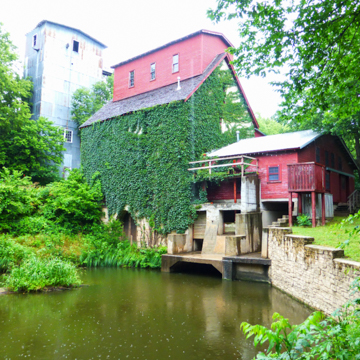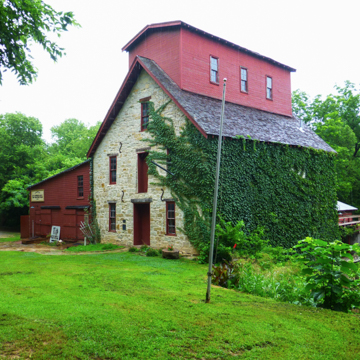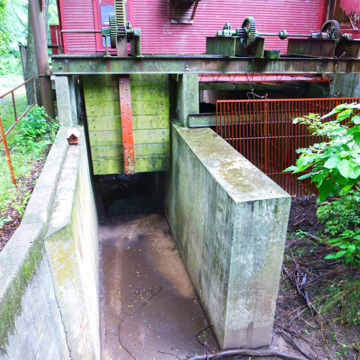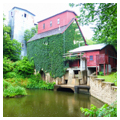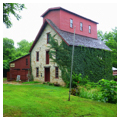You are here
Old Oxford Mill
The Old Oxford Mill is a rare reminder of a once ubiquitous Kansas building type. The survival and continuing use of the building is a testament to the fortitude and ingenuity of the citizens of the town of Oxford. In 1874, three years after the town’s founding, construction began on a gristmill in a heavily wooded valley to the north of town. Investor John M. Hewett and his partner D. N. Cook spearheaded the project, but its completion depended on the support of the townspeople. Local citizens were anxious to see the gristmill completed because it would benefit the entire community, particularly local farmers, thereby increasing Oxford’s overall economic viability. Volunteers hand-dug a half-mile-long diversion channel from the Arkansas River. A local landowner donated the stone used to line the millrace and to construct the mill building. Construction was completed in the fall of 1876 and the mill was soon operating day and night.
The original portion of the Oxford Mill is a four-story, uncoursed rubble stone structure, supported on the interior by hand-hewn timber columns and beams. The wood-shingled gable roof is topped by a small building, known as a “Texas,” sitting astride the ridge of the roof. A one-story gabled element is connected to the east of the main building; it sits above the sluice and houses the milling equipment. Another shed is attached to the north of the main building. The appendages are clad with horizontal wood siding.
At the Old Oxford Mill, burrstone wheels were used to grind both wheat and corn, but by the 1880s roller-reduction mills had begun to replace the burrstone type. The roller-reduction mills utilized cast-iron rollers more effective in processing the hard red winter wheat, which had become the grain of choice for most Kansan wheat farmers. With the introduction of this type of wheat, the amount harvested in Kansas grew from 2.5 million bushels in the 1870s to 8 million bushels in 1890 and 172 million bushels in 1914. By the mid-1880s, flour milling had become the largest industry in the state. The increasing demand for milling capability resulted in a growth in the number and size of mills. The milling business also relied on changing power supplies, from water to steam and finally to electrical power. The newer, large-scale mills were most often located along rail lines, adjacent to large grain storage facilities, and in larger communities.
Struggling to survive, the Oxford Mill tried keep its equipment up-to-date. In 1923 the old grinding machinery was replaced with roller-reduction machinery. In 1935 a new mill was built upstream, and the old mill was again re-engineered with turbines that could supply power to the new mill. The two Oxford mills managed to survive based on its convenient location and the loyalty of the surrounding farmers. But by 1977 the mills were no longer profitable and ceased operation.
By the 1980s, with the Old Oxford Mill falling into disrepair, owners Wallace Champeny and Hal Ross, substantially rebuilt the structure under the direction of architect F. Gene Ernst. The original grinding stones were replaced, and corn and wheat were once again milled, albeit on a reduced schedule. The mill ceased operation for good in 1997, and began a new life as a restaurant. Never wildly successful, the restaurant was taken over in 2008 by the Old Oxford Mill Center for Entrepreneurship, which is a joint venture between Cowley College and the local public school district. Students assist in operating the restaurant, which is open for Sunday lunch and for private parties. Although in a different manner, the Old Oxford Mill remains an asset to its community.
References
Kansas Historical Society. “Milling and Grain Storage” Kansapedia. Last modified April 2011. http://www.kshs.org/.
Wortman, Julie A., and Dale Nimz, “Old Oxford Mill,” Sumner County, Kansas. National Register of Historic Places Inventory-Nomination Form, 1982. National Park Service, U.S. Department of the Interior, Washington, D.C.
Writing Credits
If SAH Archipedia has been useful to you, please consider supporting it.
SAH Archipedia tells the story of the United States through its buildings, landscapes, and cities. This freely available resource empowers the public with authoritative knowledge that deepens their understanding and appreciation of the built environment. But the Society of Architectural Historians, which created SAH Archipedia with University of Virginia Press, needs your support to maintain the high-caliber research, writing, photography, cartography, editing, design, and programming that make SAH Archipedia a trusted online resource available to all who value the history of place, heritage tourism, and learning.

